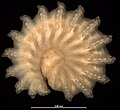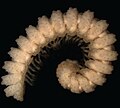| Eutrichodesmus | |
|---|---|
 | |
| Eutrichodesmus aster | |
| Scientific classification | |
| Kingdom: | Animalia |
| Phylum: | Arthropoda |
| Subphylum: | Myriapoda |
| Class: | Diplopoda |
| Order: | Polydesmida |
| Family: | Haplodesmidae |
| Subfamily: | Haplodesminae |
| Genus: | Eutrichodesmus Silvestri, 1910 |
| Synonyms [1] | |
| |
Eutrichodesmus is a genus of millipedes in the family Haplodesmidae. [2] Containing 54 species, this genus is among the genera with the greatest number of species not only in the family Haplodesmidae but also in the order Polydesmida. [3] [4] This genus includes the species E. peculiaris , notable for featuring sexual dimorphism in segment number: The adult females have 20 segments (counting the collum as the first segment and the telson as the last), but the adult males have only 19 segments. [5] Millipedes in this genus are found in southern Japan, Taiwan, southern China, mainland Southeast Asia, Indonesia, and Vanuatu. [3]







